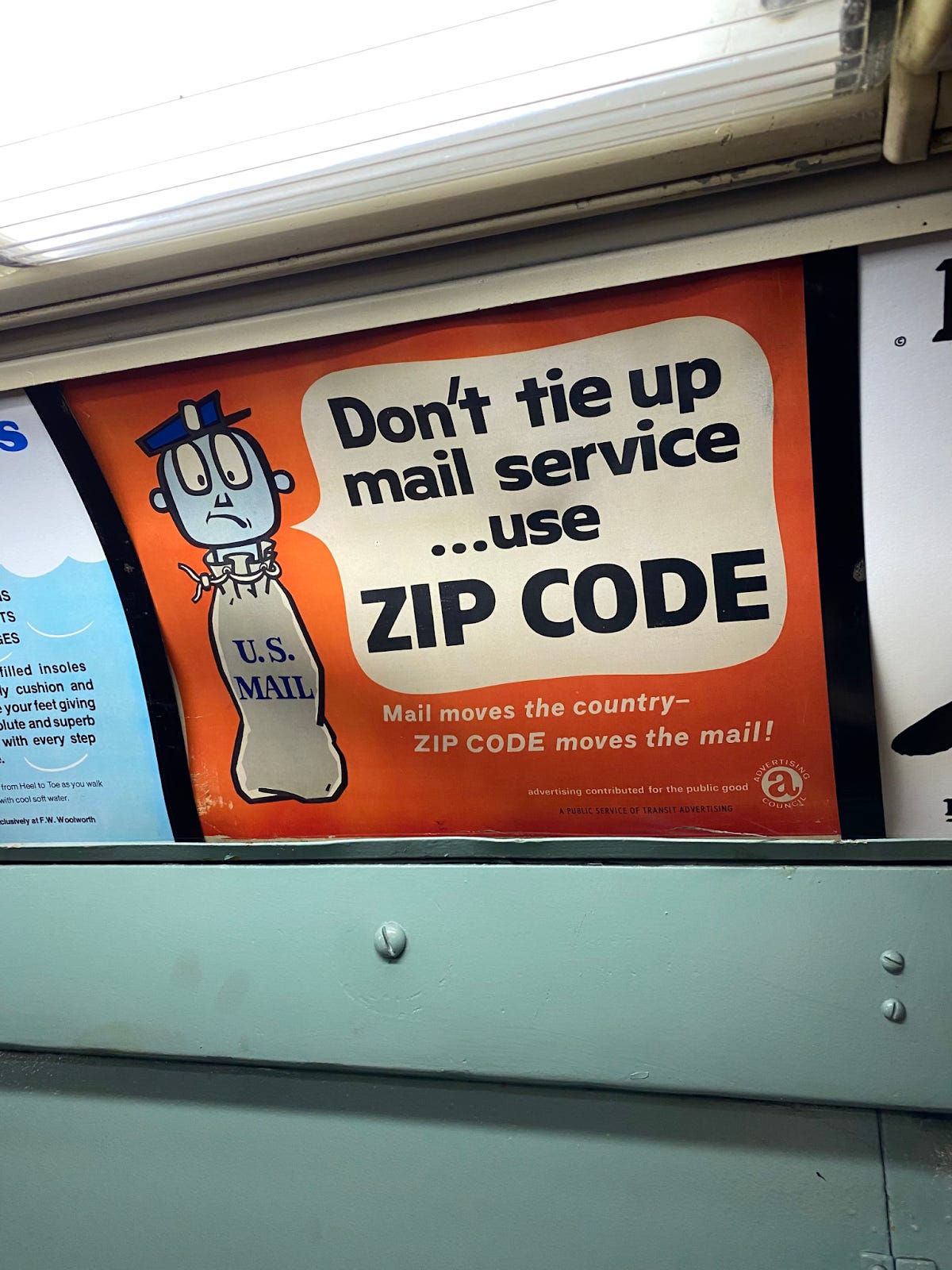Noah here. A while back I took my kids to the Transit Museum in Brooklyn. Housed in an old subway station, the museum allows visitors to walk (and in the case of my daughter run) through subway cars of the past. To make things more realistic, each train includes reproductions of ads that would have run at that time. As a marketing nerd, this is one of my favorite parts. Seeing how products and brands were advertised in earlier times is a fascinating way to understand culture. Thus the below ad, urging people to use zip codes on their mail, caught my eye.
That, if you’re not familiar, is Mr. Zip. From the USPS:
The cartoon figure, Mr. ZIP, was adopted by the Postal Service as the trademark for the Zoning Improvement Plan or ZIP Code, which began on July 1, 1963. However, the figure originated several years earlier. It was designed by Harold Wilcox, son of a letter carrier and a member of the Cunningham and Walsh advertising agency, for use by Chase Manhattan Bank in New York in a bank-by-mail campaign. Wilcox's design was a childlike sketch of a postman delivering a letter. The figure was used only a few times, then filed away.
The piece goes on to explain that AT&T bought the copyright from the ad agency and allowed the Postal Service to use it. Mr. Zip was introduced in 1962 and “within four years of his appearance, eight out of ten Americans knew who Mr. ZIP was and what he stood for.”
WITI Classifieds:
We are experimenting with running some weekly classifieds in WITI. If you’re interested in running an ad, you can purchase one through this form. If you buy this week, we’ll throw an extra week in for free on any ad. If you have any questions, don’t hesitate to drop a line.
Daly is a comms+ agency that reaches beyond the standard PR playbook to deliver results (and some magic) for our exceptional clients. Check us out
The Intermodal Spirit. Writing about Exploring, Relating, and Being. Available by newsletter or online. Subscribe here.
Parlance is a Brand Voice Advisory Studio. We Help Make the Impossible, Relatable. Learn more about our Fractional CBO model
Noah here. I've got a new newsletter about brands and AI called BrXnd Dispatch. If you're in marketing, creative, or just interested in understanding what's up with AI, check it out. Subscribe to BrXnd Dispatch
Tempo Rubato is a live classical music venue in an old factory shell in the backstreets of inner city Melbourne. Follow us on Insta
Why is this interesting?
I love stuff like this. What could be more mundane than a zip code? But at some point, it didn’t exist and the USPS needed to convince people to use it and they ran an ad campaign with a funny-looking cartoon that, at least according to the Postal Service, had 80% (!!!) awareness.
On one hand, it’s totally amazing that something like that worked. It’s hard to imagine any national ad campaign could reach these kinds of levels. Some of that is a result of the current media environment, obviously. But it’s also hard to imagine advertising something as fundamental as zip codes today. I remember seeing an old GE ad for a refrigerator that was effectively an ad for refrigeration—“keep your drinks cold for parties,” the ad promised. Would we need to advertise refrigeration today? Probably not. The last new thing that feels like it reaches these levels for me is the smartphone, but even that came years after many of us had phones in our pockets.
In the end, we don’t yet know about the things that people will look back on in sixty years and think it's unimaginable that at some moment you needed to convince people they were worth buying or using. But given modern aesthetics, it seems reasonably certain we won’t get another Mr. Zip anytime soon. (NRB)
—
Thanks for reading,
Noah (NRB) & Colin (CJN)
—
Why is this interesting? is a daily email from Noah Brier & Colin Nagy (and friends!) about interesting things. If you’ve enjoyed this edition, please consider forwarding it to a friend. If you’re reading it for the first time, consider subscribing.






At the risk of telling you what you already know, ZIP codes were, as the name says, part of a "zone improvement plan." Prior to ZIP codes, we used zone numbers, which were two digits and went between the city and the state in a mailing address (e.g., "Brooklyn, 28, NY"). The ZIP code added three numbers that helped locate the piece of mail by state, region, etc. What had been the zone number became the last two digits of the ZIP code ("Brooklyn, NY 11228")